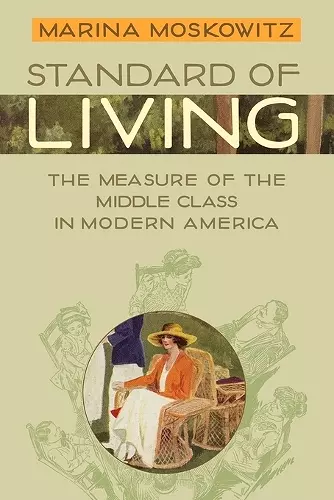Standard of Living
The Measure of the Middle Class in Modern America
Format:Paperback
Publisher:Johns Hopkins University Press
Published:23rd May '08
Currently unavailable, and unfortunately no date known when it will be back
This paperback is available in another edition too:
- Hardback£45.50(9780801879470)

Exceedingly well-written, clearly organized, and abundantly researched. There is nothing in the scholarly literature quite like this. -- Daniel Horowitz, Smith College
Concluding with a look at zoning and urban planning as a means of fostering and protecting the standard of living for whole communities, this book offers important evidence of and fresh insights into the history of the American middle class.Coined in 1902, the term "standard of living" grew popular in early twentieth-century America. Though its exact definition remained ambiguous, it most often reflected the middle class and material comfort. The term was not a precise measure of how people lived. Instead, it embodied the ideal of how middle-class Americans wanted to live. With increasing wages and the mass production of consumer goods, the standard of living became an important expression of the shared national culture that emerged in the Gilded Age and Progressive Era. But what material and social components constituted this standard? Who decided what they were and how they were to be promoted? In Standard of Living, Marina Moskowitz explores these questions, focusing on the relationship between middle-class identity and material culture through four case studies. In one, she examines the incorporation of silverplate flatware into the daily rituals of American life. Mass production made this former luxury item affordable, while advertising, etiquette books, and home advice columns stressed its value as a family heirloom and confirmed its place in the middle-class dining room. Moskowitz then turns her attention to the bathroom and the proliferation of indoor sanitation, bathroom fixtures, and a hygiene industry equally interested in profits and public health. Home ownership contributed an essential element of this standard, and Moskowitz next charts the mail-order home industry, which sold not just kit houses but also the very idea of owning a home. Concluding with a look at zoning and urban planning as a means of fostering and protecting the standard of living for whole communities, this book offers important evidence of and fresh insights into the history of the American middle class.
A thoughtful contribution to understanding the forces that ushered in modern US culture, with all of its opportunities, limitations, and peculiarities. Choice 2005 Moskowitz offers important insights into the development of American middle-class ideals of material comfort, and of an emerging shared national culture. History 2005 An ambitious and far-reaching study with implications for material history, business history, and the study of the middle class in America. Enterprise and Society 2006 Well-researched, well-written, and convincing... Will certainly influence future discussion of the expansion of the middle class and the consumer culture of the early twentieth century. Journal of Social History 2005 The strength of Marina Moskowtiz's welcome addition to this body of work lies in the author's choice of particular case studies, through which the book seeks to discover the role of material culture in defining the American middle class at the beginning of the last century. Journal of American Studies 2006 Moskowitz has creatively connected the rise of national culture and middle-class America to the emergence of a generally accepted standard of living. Register of the Kentucky Historical Society 2005 Imaginative, insightful, and lively... required reading for anyone interested in understanding how the United States became the quintessential middle-class nation. Michigan Historical Review 2006 In this well-researched monograph, Marina Moskowitz traces the evolution of the American concept of the standard of living from 1870 to the 1920s through fascinating case studies on silverplate flatware, bathroom fixtures, mail-order homes, and zoning plans. American Historical Review 2007 Moskowitz's well-written and extensively researched book investigates how the concept of the 'standard of living' became the measure of middle-class well-being and the material expression of middle-class identity during the Gilded Age and Progressive Era. Technology and Culture 2006 Refusing to recognize boundaries between social science and the novel, this innovative history rejects divisions between cultural and business history. Marina Moskowitz probes the 'standard of living' as a liminal aspiration between production and consumption that defined the American 'middle class' through the objects and spaces of the home in the late nineteenth and early twentieth centuries. Journal of American History 2006 At first glance, a study that offers in-depth case studies of such items as flatware and zoning plans might not sound like an energizing pageturner. However, Marina Moskowitz's book is both of these things and more. Moskowitz uses the stories of everyday items to craft a persuasive case for the emergence of a new, national standard of living in late-nineteenth- and early-twentieth-century America. Business History Review 2005 A compelling argument for the complexity and pervasiveness of a shared fascination with a standard of living. Journal of Interdisciplinary History 2007
ISBN: 9780801889738
Dimensions: 229mm x 152mm x 21mm
Weight: 499g
320 pages